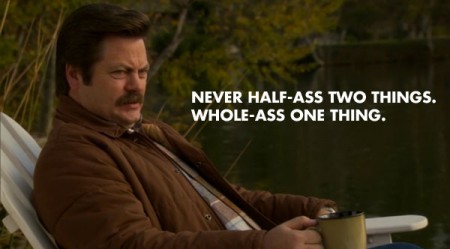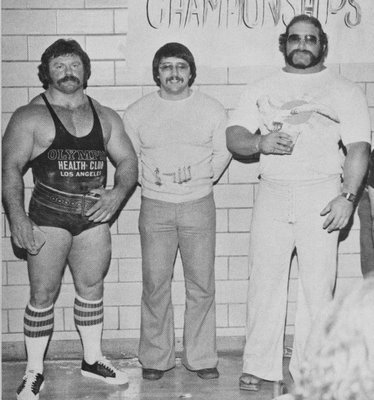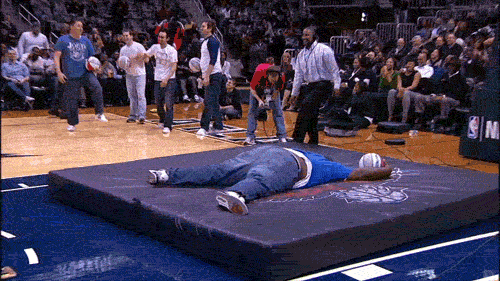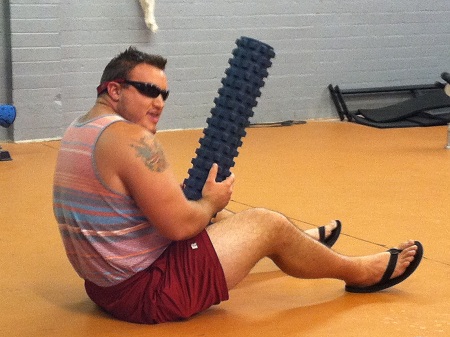“Come on you apes! You wanna live forever?”
PR Friday
As usual, post your training updates and PRs. Mingle with the crowd. Talk about the Olympics.
Weekly Challenge
Last week’s challenge aimed at getting you to create a food log for three days (2 weekdays, 1 from the weekend). How many of you actually did this? This is the standard type of food log that a coach or trainer will ask from a client. It is a pretty good representation of how they eat (by looking at both week and weekend days), yet it isn’t more invasive than a few days. I’d suggest estimating your macro count for each meal and the day and see if you can improve it given what you want and need.
Next Week’s Challenge: Curl 40kg or 90 pounds for as many reps as possible at the end of one of your training sessions next week. And watch the Olympics. Post your reps to next week’s Q&A comments.
Week In Review
Monday there was a nerd-jizz-worthy post on hyperlordosis. Tuesday focused on helping powerlifters, CrossFitters, or strength trainees to transition into Olympic weightlifting. Wednesday talked about how much of an asshole Andrei Aramnau (won gold in 105kg class in Beijing) won’t be attending the 2012 Olympics, but it’s okay because he’s an asshole. Thursday was a “deep thoughts” moment from Dr. Kilgore. There were also posts on the live streams for the NAPF Powerlifting Championships (going on right now and throughout the weekend) as well as the Olympics (the opening ceremony is tonight).
Q&A
Justin,
A little context first I’m 32 and have a 13 year old brother, dad was active after he and mom split. So to the question at hand, I have a basic garage gym set up, rogue squat rack and bar w/some bumpers a pull up bar the basic crossfit set up. I’ve been doing “crossfit” for about 5 years now. My 13 year old brother is going to be starting football this year and wants to start working out. My old man not knowing any better almost bought him one of the cheap academy/sports place “home gym” things. I luckily advised him against this. But now he wants me to show the kid how to work out and set him up with some work outs. Stephen is 13 just started puberty and hit a growth spurt he is know about 5’8” and all skin and bones. I personally know how to do the lifts but would by no means call myself a coach or an expert. Would it be wise for me to teach him how to bench and squat correctly to knowledge and set him up with a squat rack and bench and pull up bar, or just run him through body weight movements and the like? I’ve tried finding some past q&a on the subject in your website because I know I’ve seen it before but just can’t seem to find it now. Any help pointing me in the right direction would be appreciated.
Thanks
Mike
PS- doing the goruck in Austin in dec after reading your write up. Thanks for the extra push to get me to actually sign up for it.
Dear Mike,
The GoRuck will be a good time. I’ll be doing a post soon on preparing for one, so keep an eye out. In the mean time, I’d suggest walking around with about 30 pounds in a pack for about an hour once a week and add some calisthenics after you lift.
As for your little brov, the thing that will help him the most is to get stronger. That doesn’t mean you’ll ignore spatial awareness or body weight stuff, but, yes, it’ll be worth your (and his) time to learn how to squat and bench. This could be fun or frustrating for you, but with kids it’s best to be patient. As long as you have him a) squatting down all the way with b) his chest up, and c) his knees out, he’ll be fine. Remember, any weight room coaches he has will probably know less than you. As for bench, just get a little bit of pinching the shoulder blades together and work on keeping his elbows from flaring. If you need to, use a bit more of a narrow grip than you’d expect to help the elbows stay under control. Don’t progress him if they flare. This will build his triceps, which is important for any football position.
Basic agility work wouldn’t hurt him. You could teach him the “athletic position”. It’s easier than it sounds: the athlete is on the balls of their feet (which is the base of the toes), stance shoulder width, knees and hips slightly bent. It allows quick change of direction. You could have him do the standard “chop the feet” and do whatever. Side shuffle, back pedaling, up-downs, or whatever. 30 seconds to 60 seconds of whatever you think of with half that time in rest. Do this to finish his workouts off. Total training time could be less than an hour. Make sure he’s having fun and be encouraging on his progress. Teach him that this stuff will make him better at football. If he believes it, then he’ll be a better player automatically. Give him confidence and teach respect, and he’ll do well in football.
@70sBig Justin love your site. Question: tweaked my knee front squatting. Back of knee swelling but no bruising. Normal or am I a pussy?
Dear @NicMcCool,
This type of injury is related to toe angle and squatting (see first and second posts). Most people see that we eventually should have the toes pointed relatively forward, yet forget that toe angle is dependent on mobility.
Last December I had a similar injury. I did 72 clean and jerks, 31 of them with 300 pounds, for the Movember fundraiser (I don’t recommend this). My knees were crusty after this Thursday night session at my buddy Adam’s Panhandle CrossFit. Saturday I did an hour long ruck, and then Monday I was trying to warm-up to do some light or medium squats. I was squatting the bar, and tweaked the rear of my knee, just like Nic did above.
The reason is torsion. If you’ve been paying attention, you know that we want torsion, AKA torque AKA rotational force, at the hip because it helps to actively engage more musculature and more efficiently distributes the force of squatting or deadlifting across the thigh and hip. However, if a lifter doesn’t have the mobility — or their mobility has artificially been reduced due to structural stress (as in my case with the 72 clean and jerks and rucking) — then torsion can actually be an injurious act.
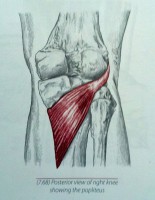 In this case, I think it’s a straining of the popliteus, a small muscle on the back of the knee (see image to the left). See how it attaches medially below the knee and laterally above the knee? When the toes are more forward, the tibia will face relatively forward. Then when the knees are shoved out, the femur (thigh) will angle outwards. See how this would tug on the poplitues if the upper attachment was pulled out while the lower attachment was kept in?
In this case, I think it’s a straining of the popliteus, a small muscle on the back of the knee (see image to the left). See how it attaches medially below the knee and laterally above the knee? When the toes are more forward, the tibia will face relatively forward. Then when the knees are shoved out, the femur (thigh) will angle outwards. See how this would tug on the poplitues if the upper attachment was pulled out while the lower attachment was kept in?
The popliteus normally aids in un-locking the knee from terminal knee extension. When the knee is flexed, as is the case in the bottom of a squat, it is contracted. My reasoning is that the muscle is shortened (contracted) at the bottom of the squat, and then the attachment sites are pulled apart (described in the preceding paragraph), resulting in a strain. For me, I know that the rucking also “worked” or “fatigued” the poplitues since each step applies more than body weight on the structure (it inevitably distributes force during walking, yet adding 50 pounds more than body weight to an already tired structure (from the CJs) will weaken and damage it even more). When I went to do the squatting movement a couple of days later, my popliteus was “crusty”, which means it was damaged, inflamed, and tender. Then I contracted it with knee flexion and then shoved my knees out which applied tension on a shortened muscle belly, and voila, it was “yanked” AKA strained.
I see this as a potential problem for people attempting “forward toe angle” style squatting when they lack the mobility in their hips, knees, and ankles to accommodate it. That’s why my suggestion has always been to make small, gradual changes to anything, whether it be mechanics or programming. At the same time, you have to take into account the other things that are going on in your training or life, because a lack of recovery can open a trainee up to small injuries like my popliteal strain. This is why when I climbed a 9,712 ft mountain last Saturday, I rested for three total days before snatching and CJing up to my month’s goals (more on this in a later post).
As for your injury, Nic, I suggest icing it as much as you can for the first several days. Mob the upper calf area with compression tack and stretch (you can do this above the knee as well) or joint capsule work with a rolled up towel tucked inside the back of the knee while in knee flexion (kind of like this vid). Ease back into squatting with light, medium, and then heavy days.
for some background, i’m 20, 5’8″ 195lbs with 15%bf. ive been lifting since high school, and it was always for football performance, so it was mostly the power lifts and just power cleans, with football conditioning. after high school i started learning the oly lifts. i’ve been doing them for about a year now, still not the best mechanics and deffinately not with a lot of weight, but i really want to focus on them because i like them so much. ive checked out the pendlay outline for a beginner template and i made my own up. could you tell me how dumb or smart it is?
mon- snatch 5×3@80% 1rm, high pulls and hang cleans 5×2 (not with significant weight, just to reinforce mechanics) high bar squat 3×5. (recently switched from low bar about a month ago when i decided to focus on oly lifts) pull ups
tues- clean and jerk 5×3@80% 1rm. high snatch pulls and hang snatches 5×2, rdls 3×8, sprints
wed-bench 3×5, bent over bb rows 3×5, db bench 3×5, db rows 3×5, push ups, lower back and ab complex
thurs- snatch 2,2,1 @90% 1rm. high bar squat 3×5, high pulls and hang snatches, press 3×5 (was doing 3×3 with ascending sets, but neglecting presses for a while has left me weak on them and im gonna just do an LP with them till i hit a wall) chins, if i have time ill do a bb complex
fri- c and j 2,2,1 @90% 1rm, high snatch pull and hang snatches, deads 1×5, dips, sled pullslooking at it, it seems like a lot. maybe it is. i havent been able to actually do this program for longer than two weeks uninterrupted due to travel and vacation, but it hasnt been too much to handle for the time ive been able to do it. i feel like i can do this template, but if it seems like im gonna drive my dick into the ground just let me know.
Dear Alphinitis,
You’ve been reading the site and commenting for a long time, so this is why I’m dealing with your long-ass, messy question. By the way, someone made fun of you for posting your BF%, but I think that is relevant information, so ignore that person.
I’m not going to dissect your program fully. But I’ll give you some of my personal philosophy with programming Olympic weightlifting. I don’t typically like partial movements for beginners. This means pulls, lifts from the hang, or from boxes. I agree with Pendlay that the positions are incredibly important, and these partial lifts may develop those, but I think it over complicates things for a beginner. Not to mention, in my opinion, they just need time to do the full lifts over and over with at least okay positioning (this would grade them out at a “B”). Instead, you are getting reps with tons of partial movements that may or may not be correct to begin with. I’d rather you just do the full lifts.
I don’t like to think in terms of percentages until the mid to late stage intermediate programming of anything. Modern society wants to be told exactly what to do, but programming is more organic than that. Doing whatever for a percentage may be the optimal stress in a given week, but who is to say that it will be several weeks from now? Or the first several weeks of a program? That’s why I indicated a steady progression in the program earlier this week.
You also have a day in which you bench, and then the next day you are snatching. I don’t know if you’ve ever benched heavy and then snatched heavy (I’ve done this in a session), but it’s not good. Not good at all.
By my count, you’re aiming to train five days a week. You already know I’m not a fan of that, especially for someone in your position that is transitioning into weightlifting. Rest is important to recover and get stronger from compound movements that impart a systemic stress. You are young, but I’d rather you learn this lesson now instead of doing it the hard way.
Lastly, I see a bunch of random shit tacked on the end of the training sessions. Dumbbell work and what not. Focus your efforts, mate. You already know why, but Ron Swanson will help:

